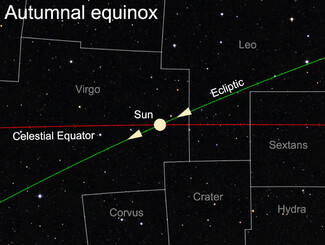Autumn Is Coming ... Finally!
Last updated 11/9/2023 at 1:27pm
Seasons come and seasons go, and over our lives we've all become accustomed to this pattern. When I was young, I looked forward to summer because we got a few months off from school and had great weather to swim, travel or just lay around and do nothing.
Having lived in the Southwestern U.S. deserts for half my life, however, I now look forward to the cooler days and nights of autumn. And this week, I'm absolutely giddy with excitement. That's because autumn is coming. Finally!
This year, autumn officially began in our planet's Northern Hemisphere on Sept. 23 at 2:05 a.m. EDT, but on the U.S. West Coast, it occured on Sept. 22 (11:05 p.m. PDT).
Many people think that autumn begins on the day that we see the sun rise due east and set due west, or when the length of our daytime and nighttime are equal. If we don't concern ourselves with fine details, both are somewhat true statements.
So why, then, did I cite the exact time for the beginning of autumn? That's because the onset of autumn – the autumnal equinox -- is not a day, but rather a moment in time. It's marked by the sun's passage in the heavens from the Northern Hemisphere sky into the Southern Hemisphere sky. It occurs, in fact, the moment the sun crosses the celestial equator on its journey from north to south.
Confused? Well, try to imagine what's going on.
During summertime, we in the Northern Hemisphere see the sun cross our daytime sky high overhead, but during wintertime, it crosses relatively low in the southern sky. This happens because our planet's equator is tipped about 23.4 degrees to the plane of its orbit around the sun.
At some point during the year, however, the sun – traveling along its orbit (called the "ecliptic") – must cross the equator on its way southward, and that defines the moment known as the autumnal equinox. When this occurs, our sun appears directly overhead for viewers on the Earth's equator.
Now try to imagine standing at the equator. On the first day of autumn, you'd see the sun pass directly overhead. A few days or weeks earlier, the sun would have crossed your northern sky, and a few days or weeks later, it would cross your southern sky. But on that day, the sun stands directly over the equator, so you would watch it pass directly overhead at midday.
Another way to think about it is to imagine extending a projection of the Earth's equator into the starry heavens. This would create in the sky what astronomers call the "celestial equator." The moment when the sun crosses this great circle on its way south marks the autumnal equinox, and the onset of autumn in the Earth's Northern Hemisphere.
One easy way to watch how the sun's position changes at this time of year is to notice how the sunset point drifts southward along the horizon over several days or weeks. To do this, you must have only a fixed observing location, but be careful not to look directly at the sun itself or you may suffer irreversible eye damage.
Visit Dennis Mammana at dennismammana.com.




